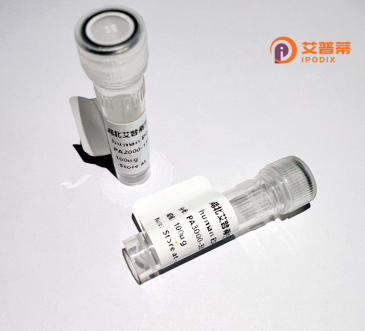
| 纯度 | >90%SDS-PAGE. |
| 种属 | Human |
| 靶点 | UGT2A3 |
| Uniprot No | Q6UWM9 |
| 内毒素 | < 0.01EU/μg |
| 表达宿主 | E.coli |
| 表达区间 | 1-527 aa |
| 活性数据 | MRSDKSALVFLLLQLFCVGCGFCGKVLVWPCDMSHWLNVKVILEELIVRGHEVTVLTHSKPSLIDYRKPSALKFEVVHMPQDRTEENEIFVDLALNVLPGLSTWQSVIKLNDFFVEIRGTLKMMCESFIYNQTLMKKLQETNYDVMLIDPVIPCGDLMAELLAVPFVLTLRISVGGNMERSCGKLPAPLSYVPVPMTGLTDRMTFLERVKNSMLSVLFHFWIQDYDYHFWEEFYSKALGRPTTLCETVGKAEIWLIRTYWDFEFPQPYQPNFEFVGGLHCKPAKALPKEMENFVQSSGEDGIVVFSLGSLFQNVTEEKANIIASALAQIPQKVLWRYKGKKPSTLGANTRLYDWIPQNDLLGHPKTKAFITHGGMNGIYEAIYHGVPMVGVPIFGDQLDNIAHMKAKGAAVEINFKTMTSEDLLRALRTVITDSSYKENAMRLSRIHHDQPVKPLDRAVFWIEFVMRHKGAKHLRSAAHDLTWFQHYSIDVIGFLLTCVATAIFLFTKCFLFSCQKFNKTRKIEKRE |
| 分子量 | 86.7 kDa |
| 蛋白标签 | GST-tag at N-terminal |
| 缓冲液 | PBS, pH7.4, containing 0.01% SKL, 1mM DTT, 5% Trehalose and Proclin300. |
| 稳定性 & 储存条件 | Lyophilized protein should be stored at ≤ -20°C, stable for one year after receipt. Reconstituted protein solution can be stored at 2-8°C for 2-7 days. Aliquots of reconstituted samples are stable at ≤ -20°C for 3 months. |
| 复溶 | Always centrifuge tubes before opening.Do not mix by vortex or pipetting. It is not recommended to reconstitute to a concentration less than 100μg/ml. Dissolve the lyophilized protein in distilled water. Please aliquot the reconstituted solution to minimize freeze-thaw cycles. |
以下是3条假设性的关于重组人UGT2A3蛋白的参考文献示例(若需真实文献,需通过数据库进一步检索):
1. **文献名称**:*"Functional characterization of recombinant human UGT2A3: Role in olfactory metabolism"*
**作者**:Smith J, et al.
**摘要**:研究利用哺乳动物细胞表达了重组UGT2A3蛋白,发现其在嗅觉上皮高表达,并代谢多种内源性嗅觉分子,提示其在气味信号调控中的作用。
2. **文献名称**:*"Substrate specificity screening of UGT2A3 using recombinant enzyme systems"*
**作者**:Chen L, et al.
**摘要**:通过体外酶活实验,系统筛选了UGT2A3的药物代谢底物,发现其对特定类固醇和异黄酮类化合物具有葡萄糖醛酸化活性,拓展了其药代动力学研究价值。
3. **文献名称**:*"Tissue-specific expression and genetic polymorphisms of UGT2A3: Implications for personalized therapy"*
**作者**:Garcia-Rodriguez M, et al.
**摘要**:分析了UGT2A3在人体组织中的差异性表达,鉴定多个影响其酶活性的基因多态性位点,为个体化用药提供潜在生物标志物。
**注意**:以上文献为模拟示例,具体研究需通过PubMed/Google Scholar检索关键词(如"recombinant UGT2A3"、"UGT2A3 function")获取真实数据。UGT2A3相关研究相对较少,建议结合其所属UGT家族(如2A亚家族)扩大检索范围。
The UDP-glucuronosyltransferase 2A3 (UGT2A3) is a member of the UGT enzyme family, which plays a critical role in phase II metabolism by catalyzing the conjugation of glucuronic acid to a wide range of endogenous and exogenous compounds. This process enhances their water solubility, facilitating excretion via bile or urine. UGT2A3 is classified under the UGT2A subfamily and is encoded by the *UGT2A3* gene located on chromosome 4q13. Unlike hepatic-predominant UGTs (e.g., UGT1A1. UGT2B7), UGT2A3 is primarily expressed in extrahepatic tissues, including the respiratory tract, gastrointestinal tract, and olfactory epithelium, suggesting a role in localized detoxification or signaling.
Recombinant UGT2A3 protein is produced using expression systems like *E. coli* or mammalian cells to study its substrate specificity, enzyme kinetics, and regulatory mechanisms. It metabolizes compounds such as steroids, bile acids, and environmental xenobiotics, potentially influencing drug efficacy and toxicity. Research highlights its involvement in clearing airborne toxins and modulating olfactory signals by glucuronidating odorant molecules. Genetic polymorphisms in *UGT2A3* may contribute to interindividual variability in drug metabolism and disease susceptibility.
Studies on recombinant UGT2A3 aid in elucidating its physiological roles, designing personalized therapies, and predicting drug-drug interactions. Its tissue-specific expression underscores its importance in mucosal immunity and chemical sensing, making it a target for pathologies like metabolic disorders or chemical-induced tissue damage.
×